This post may contain affiliate links. For more information, please see our affiliate policy.
Hearty comfort food at its Midwestern best, this Booyah Stew is a chicken and beef stew is a fan-favorite that deserves the starring role as part of your potluck or tailgate menu.
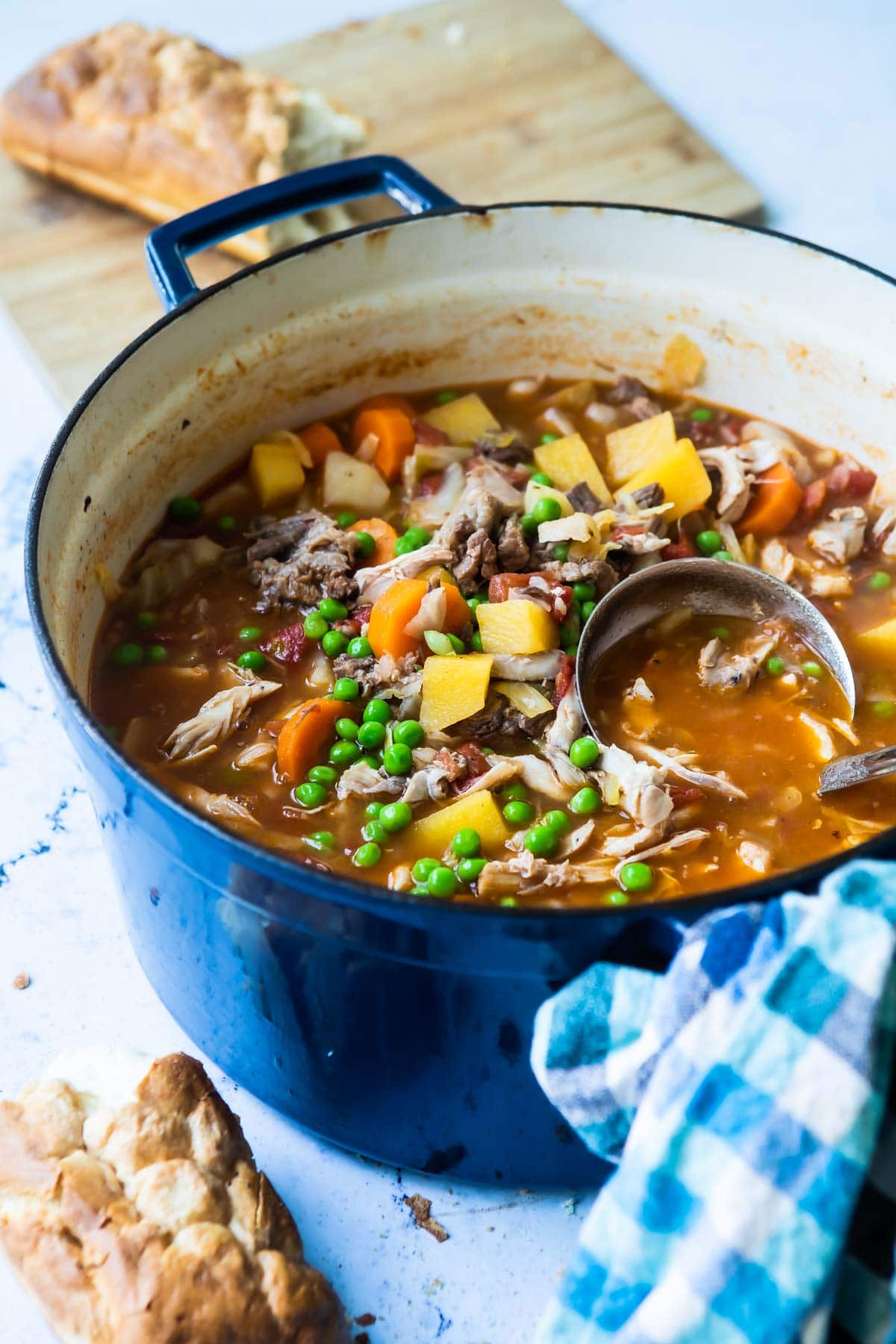
In the upper Midwest, especially in prime Packer territory of Northeast Wisconsin, it’s common to find a giant kettles of piping hot, velvety booyah simmering over an open fire on chilly fall days. “Green Bay Booyah” or Booyah Soup is a staple at community at booyah fundraisers, as part of tailgate menus, and beyond.
But now that I’ve perfected a homemade stew recipe inspired by that beloved booyah, you can live anywhere in the world and still savor this comfort food dinner idea.
While the exact origin story of Booyah Stew is hazy, the dish seems to have roots in Belgium. Its name, though, likely comes from the French word bouillon, for “broth;” the way it’s pronounced is very similar to “booyah.”
As far as the Wisconsin connection goes, back in 1906, a Green Bay teacher, Andrew Rentmeester, wanted to raise money for his school and came up with the idea of serving the Belgian dish, bouillon, at the event. He gathered up beef and chickens from the neighbors for the hearty stew. The news reporter who was covering the event scribbled down “booyah” instead of bouillon, and since then, the state (and beyond) has been graced with one of the heartiest stews possible.
Sometimes booyah is spelled booya, bouja, boulyaw, or bouyou, but no matter what, it’s a protein-rich, vegetable-packed stew made with chicken, beef, or pork and carrots, peas, cabbage, tomatoes, potatoes, and more. It’s one of a handful of regional recipes that are made with what’s on hand, like Mulligan stew, gumbo, or burgoo.
Admittedly, this Booyah recipe is a labor of love. But the chicken and short rib beef broth (sounds wild; tastes wildly delicious!) makes this comfort food recipe unlike any other chicken stew or beef stew you’ve spooned.
So grab your biggest pot and get to work! No live fire required. My twist on classic Booyah Stew recipe is made right on the stove, and I pared it down to feed a family (with enough for leftovers) instead of a whole town.
Table of Contents
Recipe ingredients
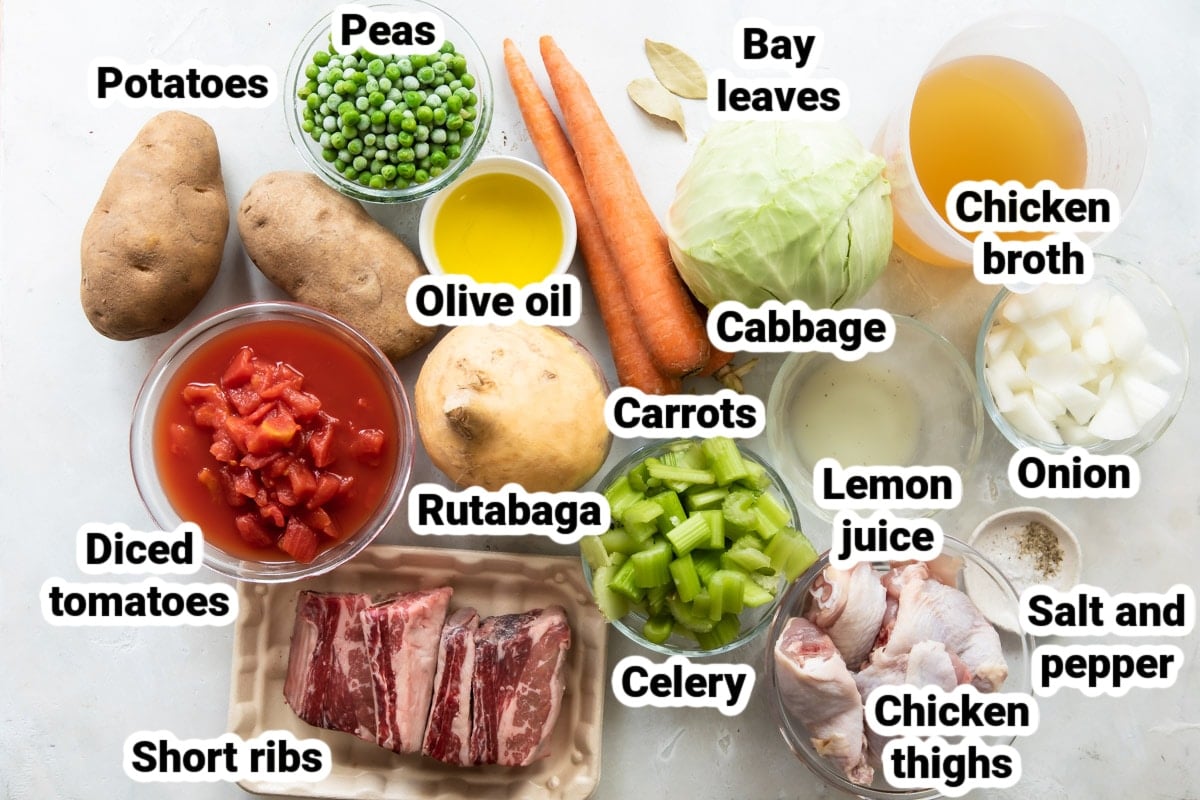
At a Glance: Here is a quick snapshot of what ingredients are in this recipe.
Please see the recipe card below for specific quantities.
Ingredient notes
- Bone-in short ribs and chicken thighs: The bones lend a thick, luscious consistency to the homemade broth. After cooking the beef, be sure to remove any extraneous cartilage before shredding; leaving that in can make some bites too chewy to consume.
- Chicken broth: You’ll need 8 cups of chicken broth, which is about 4 small cans or 2 large cartons of store-bought. You have my full permission to snag some at the supermarket, since you’ll be stoking the flavor with more umami from chicken thighs and short ribs as part of the process for this Booyah Stew. But if you’re really feeling ambitious, feel free to start with Homemade Chicken Broth.
- Rutabaga: Not a fan of this root vegetable? Leave it out and add an extra potato. Or, add any other vegetables you want like celery stalks, green beans, and corn.
- Lemon wedges: These are optional, but highly recommended; squeeze on just prior to serving for a welcome burst of acidity and brightness. If you have any fresh herbs like parsley or cilantro floating around, feel free to toss those on as a garnish as well.
Step-by-step instructions
To make the broth:
- Pat beef and chicken dry with paper towels and season on both sides with salt and pepper. In a large Dutch oven or large stockpot (at least 5 ½ quarts), heat olive oil until just smoking. Add beef and cook, flipping occasionally, until browned on all sides, about 10 minutes total. Remove from pot and set aside.
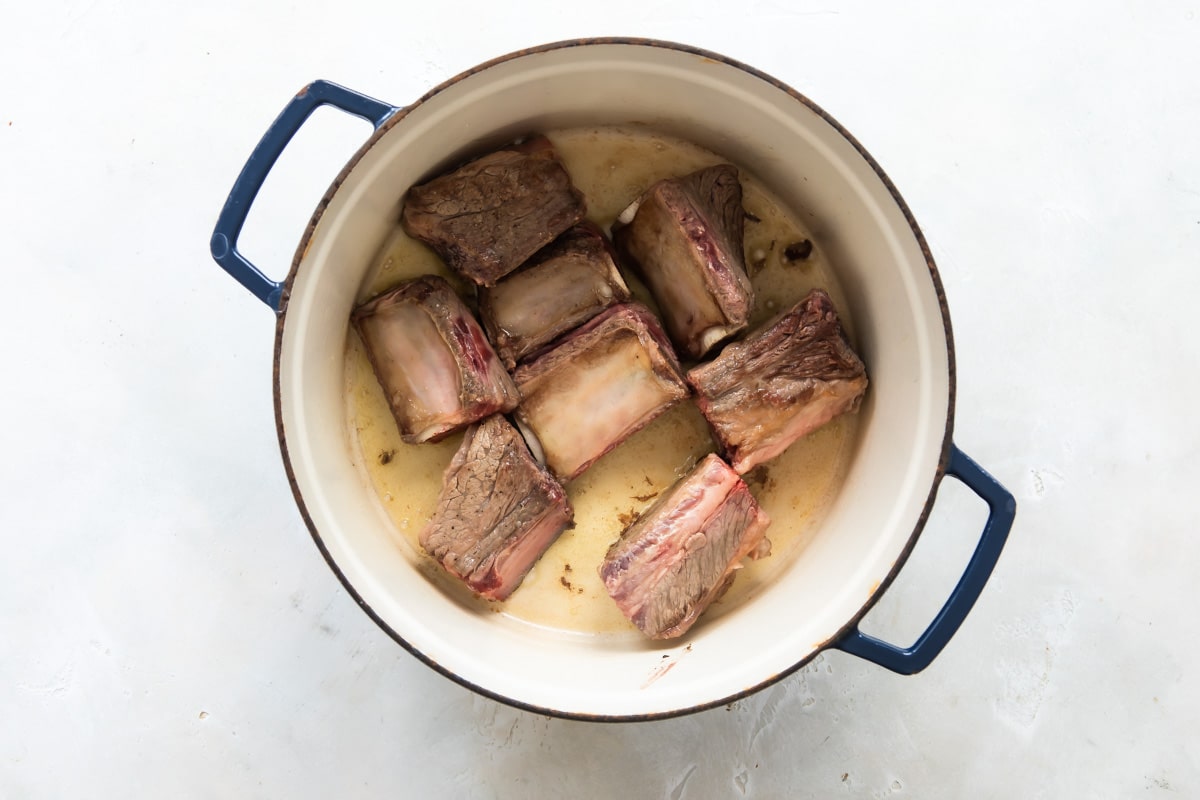
- Add the chicken to the pot and cook, flipping occasionally, until browned on both sides, about 10 minutes total. Remove from pot set aside. When the chicken is cool enough to handle, remove and discard skin. Do not drain fat from pot.
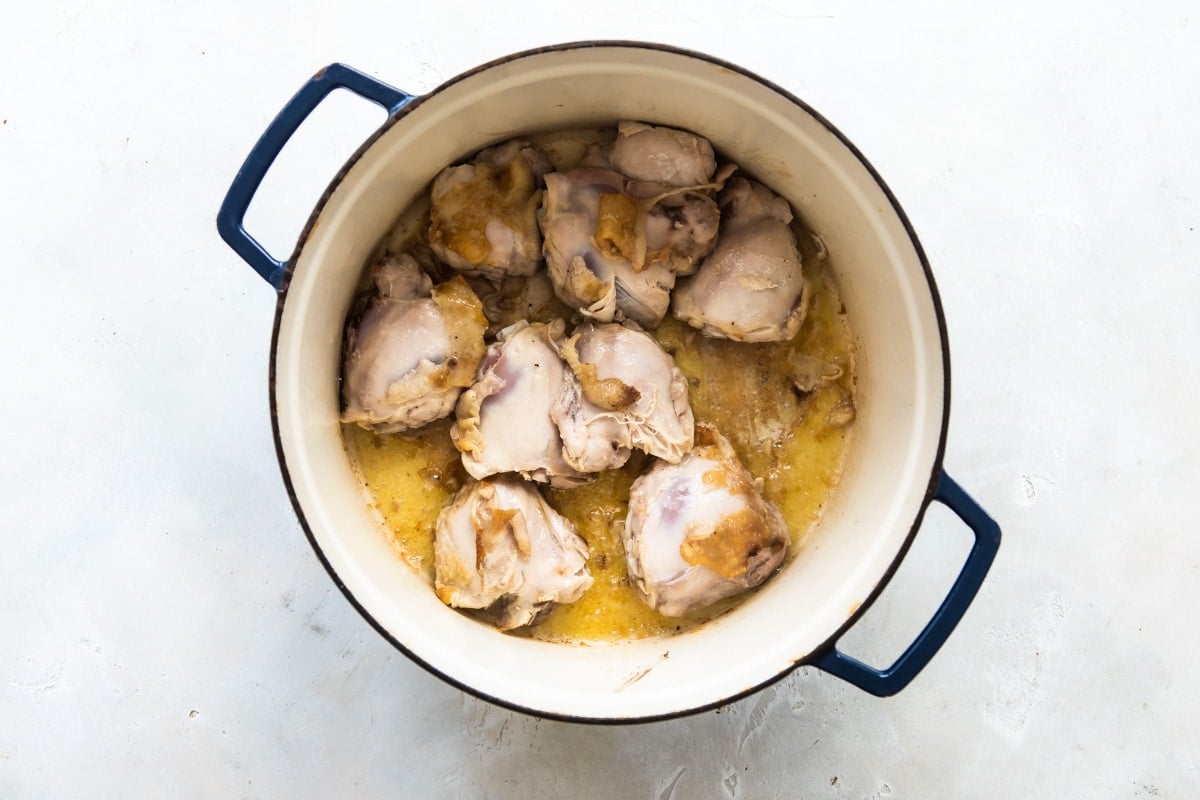
- In the same pot, reheat rendered fat over medium heat until shimmering. Add onions and celery, and cook until softened, about 3 to 5 minutes.
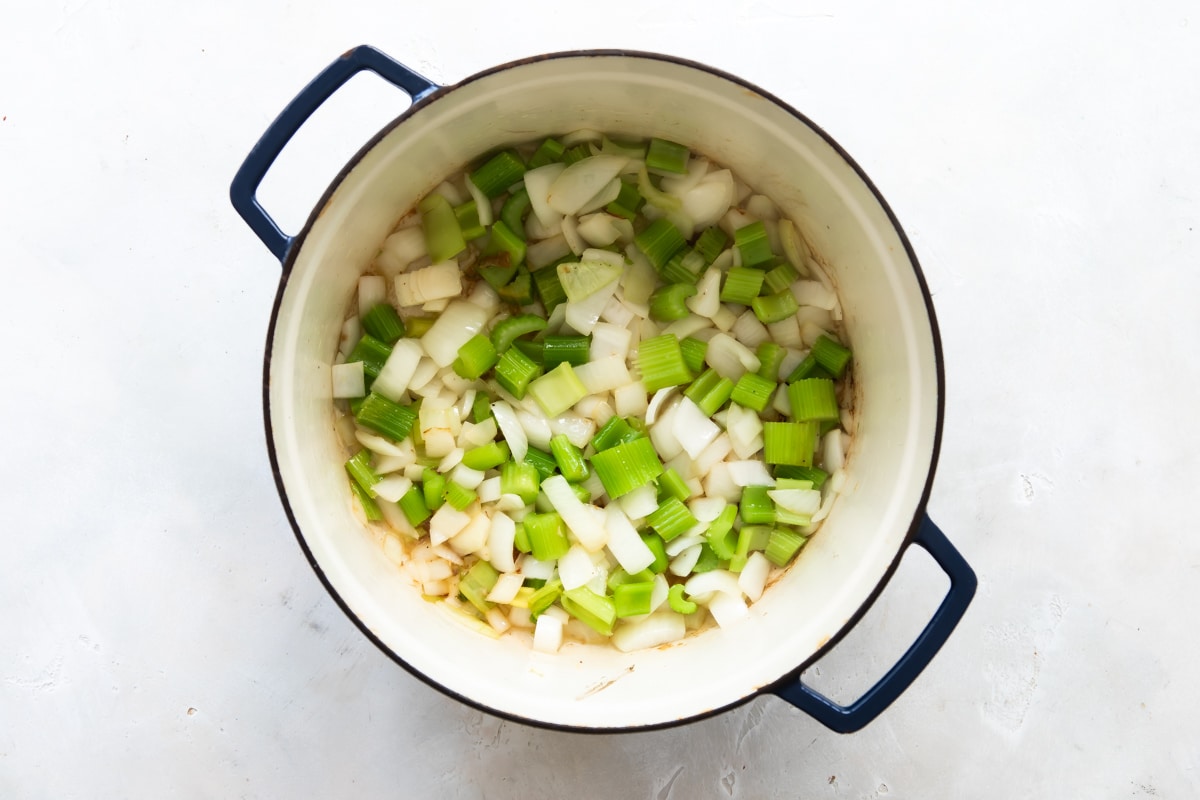
- Stir in broth and bay leaves, scraping up any browned bits on the bottom of the pot. Add back short ribs and chicken, and bring to boil. Reduce heat to low, cover, and simmer until chicken is 175 degrees on an instant-read thermometer, about 25 to 30 minutes.
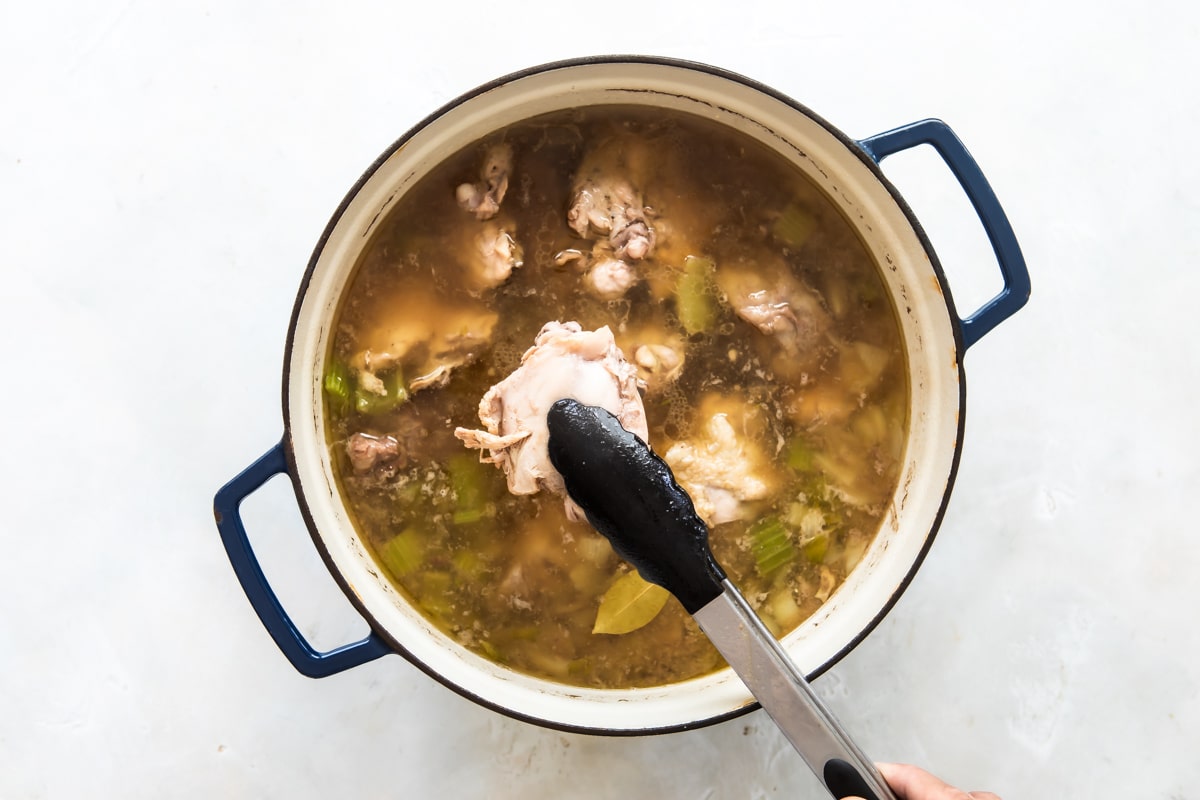
- Remove chicken from pot. When chicken is cool enough to handle, remove and discard bones. Shred chicken into bite-sized pieces. Cover and refrigerate chicken.
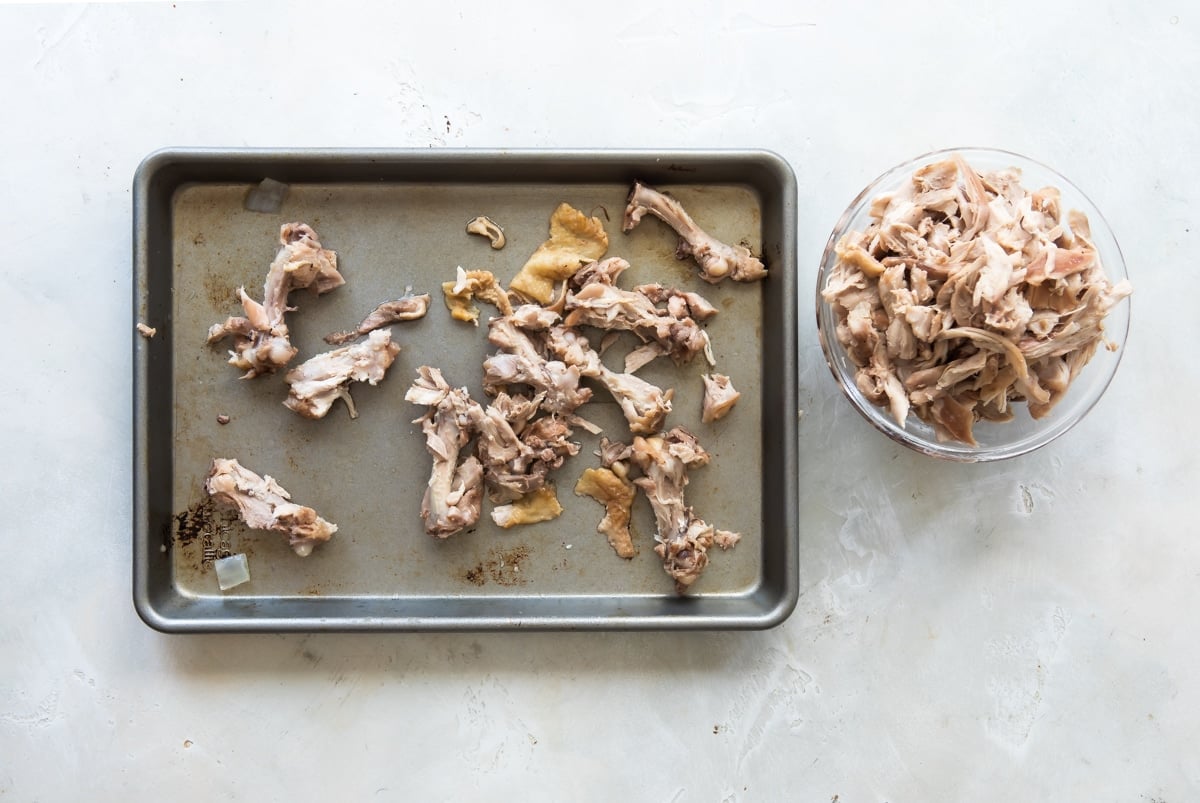
- Continue cooking the stew until the beef is tender, about 75 to 90 minutes longer. Remove beef from pot. When beef is cool enough to handle, remove and discard fat, bones, and any inedible connective tissue.
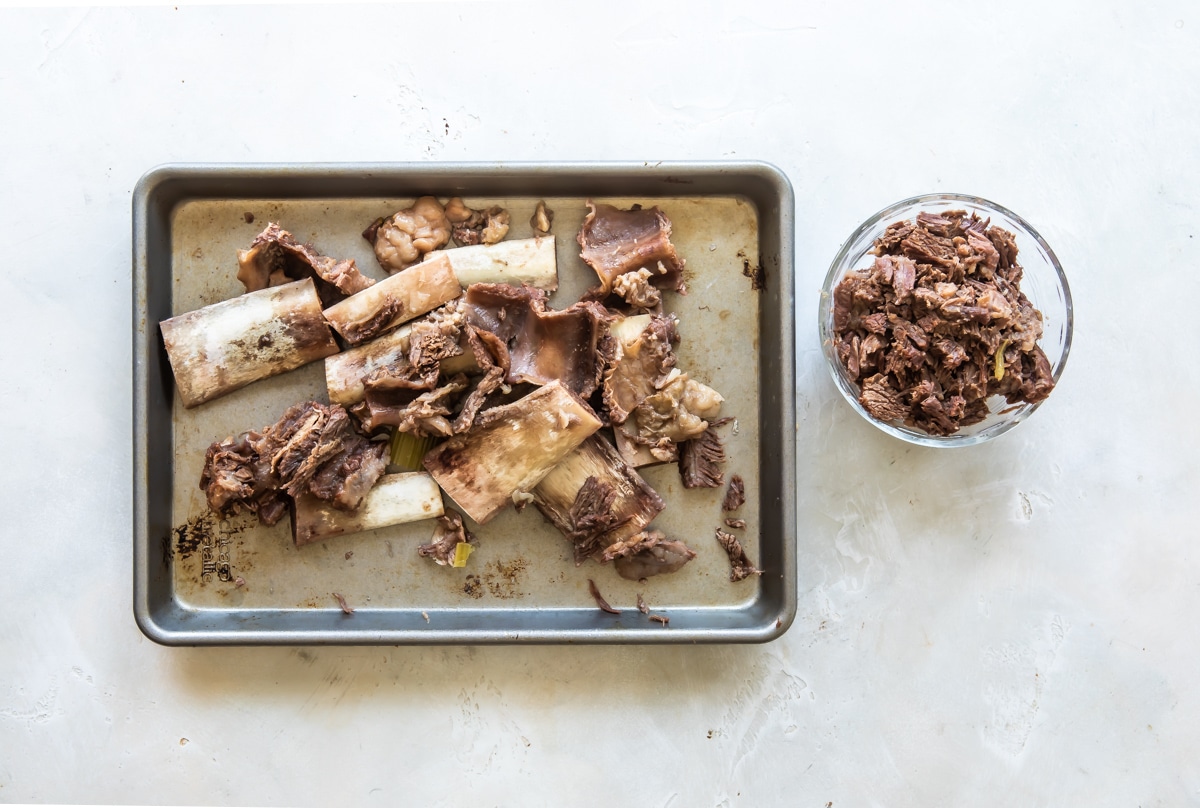
- Strain broth through a fine-mesh strainer, discarding solids.
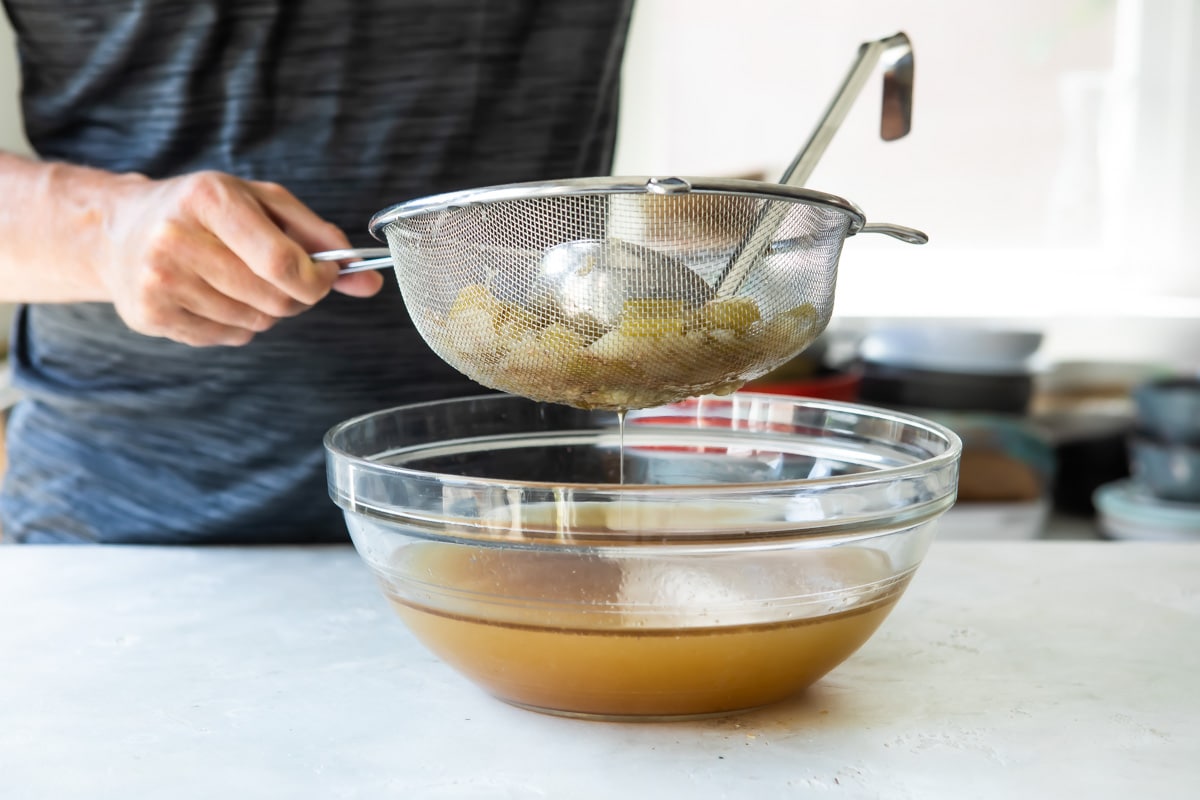
- Allow liquid to settle, about 5 minutes, then skim off fat and return liquid to pot (expect 1-2 cups of fat).
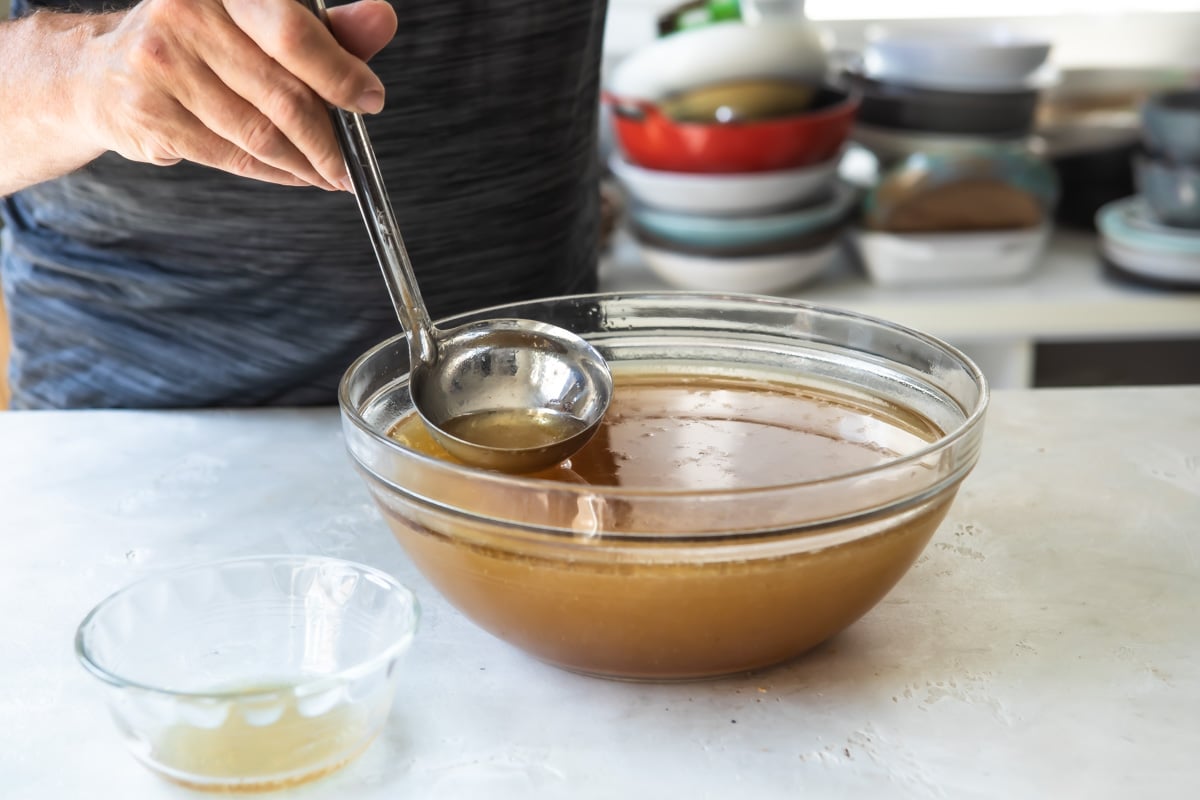
To make the stew:
- To the pot with the broth, add the shredded beef, cabbage, diced tomatoes and juice, rutabaga, potato, and carrots. Reduce heat to medium and simmer until all vegetables are tender, 30 to 35 minutes.
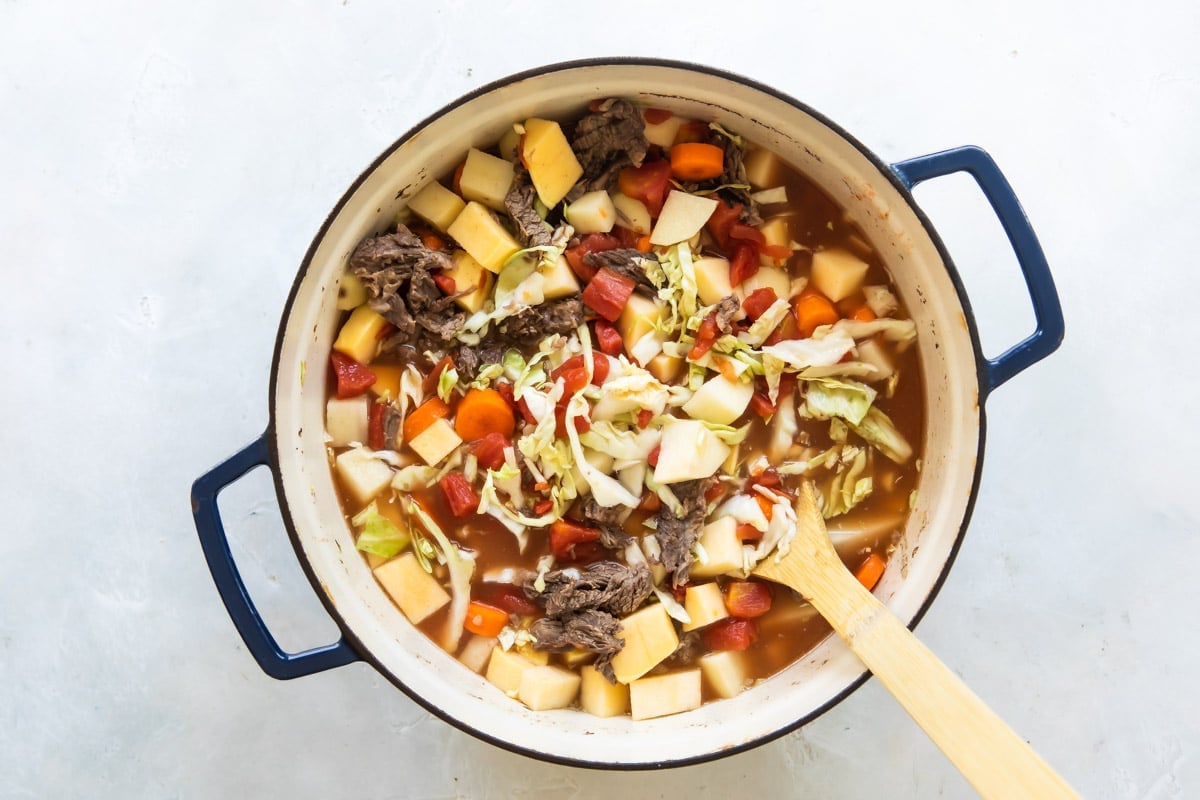
- Add chicken and peas and cook until heated through, stirring occasionally. Season to taste with salt and pepper. Serve with fresh lemon wedges if desired.
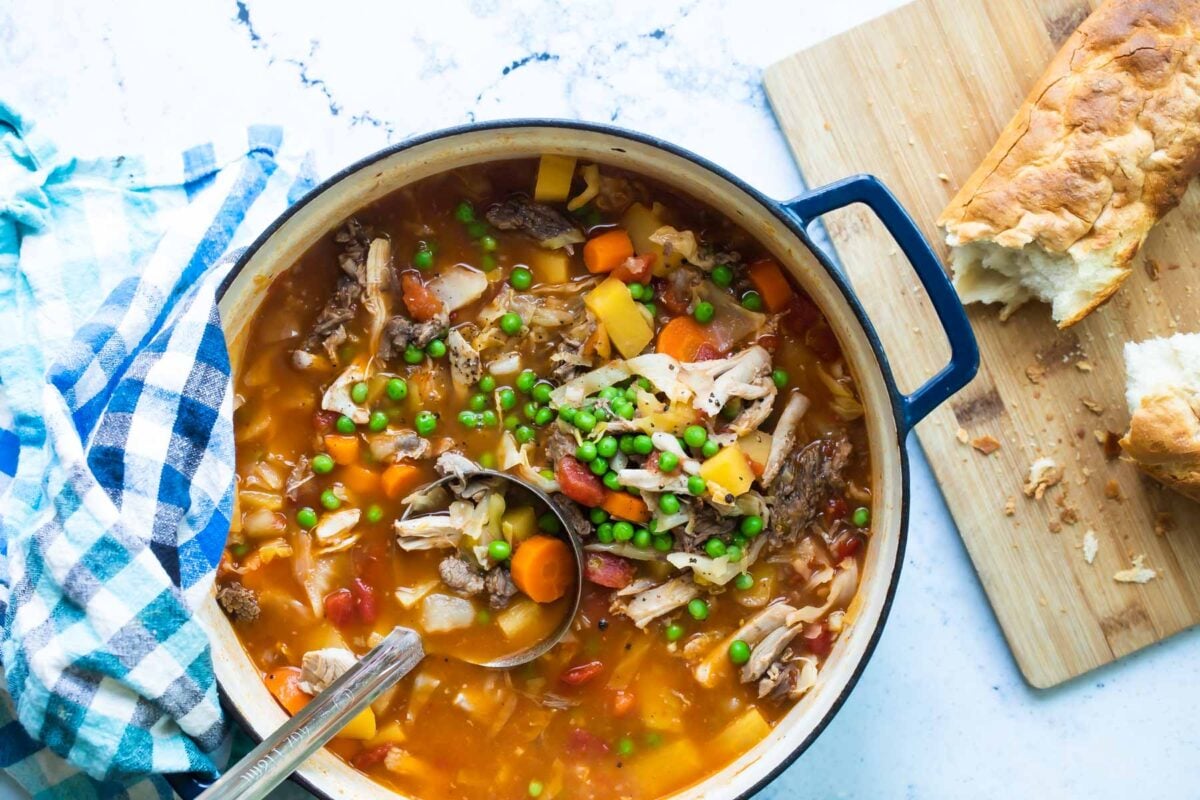
Recipe tips and variations
- Yield: This recipe will make about 5 quarts (20 cups!) of stew, enough for 10 generous 2-cup servings.
- Storage: Store leftovers covered in the refrigerator for up to 4 days.
- Make ahead: The broth can be (and in a perfect world, would be) made a day or two in advance. It’s much easier to scrape excess fat off the top of the broth when it’s chilled.
- Freezer: Booyah is ideal for freezing because it’s labor-intensive AND makes a giant batch. Make it once and enjoy it again later! Cool and package into freezer-safe containers. Label, date, and freeze for up to 3 months. Thaw overnight in the refrigerator before reheating.
- Variations: Some cooks substitute pound for pound beef stew meat instead of short ribs. They are certainly easier to work with, but the final stew will lack some of the richness of classic Booyah. You could also add fresh herbs like rosemary and thyme; I wanted to, but I used a restrained hand to honor the real deal. Nobody is fiddling with sprigs of rosemary in the pre-dawn hours of a Lambeau Field parking lot! But they would definitely be welcome additions.
- Tailgating menu: Booyah is the maybe the best possible Tailgating food ever created, but for more inspiration, see my full menu of Tailgating recipes including Hot Dog Chili for Chili Dogs, Beer Brats, Baked Beans, Puppy Chow, Cowboy Caviar, Jello Shots, and more.
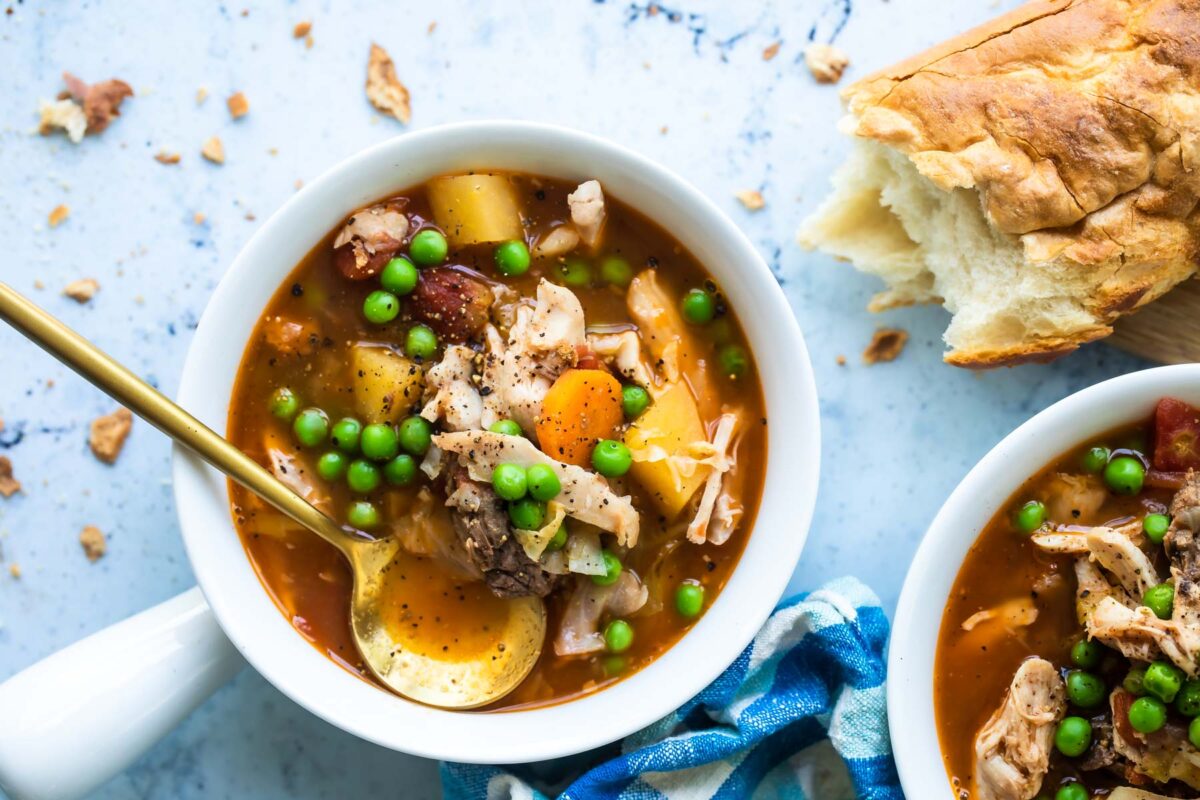
Frequently Asked Questions
To remove the fat from the broth, you can spoon it off the top of the broth or use a fat separator. Or, if you have the time, refrigerator the strained broth for 8 hours or overnight (store the beef, chicken, and vegetables covered in the refrigerator). The next day, the fat will have risen to the top and hardened and can be easily removed. Proceed with the stew, adding the shredded beef and vegetables to the broth while reheating it.
The CDC (and I!) recommend that you never wash chicken, as this can splatter raw chicken juices onto your sink and any nearby surfaces. There’s no need to wash poultry before cooking, but do pat it dry for a solid sear.
No special equipment is necessary. Simply place the cooked protein in a clean cutting board, then use two forks (backs facing each other) to pull the meat in separate directions until you have bite-sized pieces. Discard any pieces of gristle, connective tissue, cartilage, or fat.
More Midwestern favorites
Grilling and Smoker Recipes
Wisconsin Beer Brats
Cocktail Recipes
Brandy Old Fashioned
Entertaining
Friday Night Fish Fry
Salad Recipes
Broccoli Salad with Bacon and Cheese
Join Us
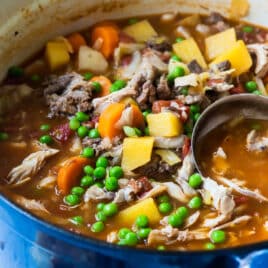
Booyah Stew
Ingredients
For the broth:
- 2 1/2 pounds bone-in short ribs trimmed (see note 1)
- 2 1/2 pounds bone-in chicken thighs trimmed
- Salt and freshly ground black pepper
- 1 tablespoon olive oil
- 2 onions coarsely chopped
- 2 celery ribs coarsely chopped
- 8 cups chicken broth (see note 2)
- 2 bay leaves
For the stew:
- 4 cups cabbage shredded (from 1 small head)
- 28 ounces diced tomatoes undrained
- 8 ounces rutabaga peeled and cut into 1/2-inch pieces (1-2 small, see note 3)
- 1 pound russet potatoes peeled and cut into 1/2-inch pieces (1 large)
- 3 large carrots peeled and sliced 1/4-inch thick
- 1 cup frozen peas
- lemon juice for serving, optional (see note 4)
Instructions
To make the broth:
- Pat beef and chicken dry with paper towels and season on both sides with salt and pepper.
- In a large Dutch oven or large stockpot (at least 5 ½ quarts), heat olive oil until just smoking. Add beef and cook, flipping occasionally, until browned on all sides, about 10 minutes total. Remove from pot and set aside.
- Add the chicken to the pot and cook, flipping occasionally, until browned on both sides, about 10 minutes total. Remove from pot set aside. When the chicken is cool enough to handle, remove and discard skin. Do not drain fat from pot.
- In the same pot, reheat rendered fat over medium-high heat until shimmering. Add onions and celery, and cook until softened, about 3 to 5 minutes.
- Stir in broth and bay leaves, scraping up any browned bits on the bottom of the pot. Add back short ribs and chicken, and bring to boil. Reduce heat to low, cover, and simmer until chicken is 175 degrees on an instant-read thermometer, about 25 to 30 minutes.
- Remove chicken from pot. When chicken is cool enough to handle, remove and discard bones. Shred chicken into bite-sized pieces. Cover and refrigerate chicken.
- Continue cooking the stew until the beef is tender, about 75 to 90 minutes longer. Remove beef from pot. When beef is cool enough to handle, remove and discard fat, bones, and any inedible connective tissue.
- Strain broth through a fine-mesh strainer, discarding solids. Allow liquid to settle, about 5 minutes, then skim off fat and return liquid to pot (expect 1-2 cups of fat; see note 3).
To make the stew:
- To the pot with the broth, add the shredded beef, cabbage, diced tomatoes and juice, rutabaga, potato, and carrots. Reduce heat to medium and simmer until all vegetables are tender, 30 to 35 minutes.
- Add chicken and peas and cook until heated through, stirring occasionally. Season to taste with salt and pepper (I like ate least 1 teaspoon salt and 1 teaspoon pepper, and sometimes I add more). Serve with fresh lemon wedges if desired.
Recipe Video
Notes
- Bone-in short ribs and chicken thighs: The bones lend a thick, luscious consistency to the homemade broth. After cooking the beef, be sure to remove any extraneous cartilage before shredding; leaving that in can make some bites too chewy to consume.
- Chicken broth: You’ll need 8 cups of chicken broth, which is about 4 small cans or 2 large cartons of store-bought. If you’re really feeling ambitious, feel free to start with Homemade Chicken Broth.
- Rutabaga: Not a fan of this root vegetable? Leave it out and add an extra potato.
- Lemon wedges: These are optional, but highly recommended; squeeze on just prior to serving for a welcome burst of acidity and brightness.
- Yield: This recipe will make about 5 quarts (20 cups!) of stew, enough for 10 generous 2-cup servings.
- Storage: Store leftovers covered in the refrigerator for up to 4 days.
- Make ahead: The broth can be made a day or two in advance. It’s much easier to scrape excess fat off the top of the broth when it’s chilled.
- Freezer: Cool and package into freezer-safe containers. Label, date, and freeze for up to 3 months. Thaw overnight in the refrigerator before reheating.
Nutrition
Meggan Hill is a classically-trained chef and professional writer. Her meticulously-tested recipes and detailed tutorials bring confidence and success to home cooks everywhere. Meggan has been featured on NPR, HuffPost, FoxNews, LA Times, and more.




Fabulous! Addictive. Read its history.
4 out of 5 Stars! A key to great Booyah is the seasoning – which is lacking with most recipes. I created my own blend of Savory Seasoning, then added two additional spices – white pepper and ?? – some things are meant to be kept secret! In order to create a traditional 24-hour Booyah, I used a whole roaster to create the broth, I then simmered Oxtail, Beef Short Ribs, and Beef shanks for 4 hours to add another layer of flavor to the broth. I reserved the water from the beef, and refrigerated it over night, then took the cold fat off the top to reveal a beautiful, gelatinous beef stock, which I then added back to the Booyah for another layer of flavor! Thanks for sharing – Booyah is now in my seasonal rotation!
I’m 66 and born and raised in Green Bay. I attended Catholic school from 1st to 8th grade. Parishes scheduled their summer picnics on different Sunday’s throughout the summer and my sister and I when in our 20’s & 30’s visited most of them with our children for booyah, games, raffles and the dessert tent.
As a child attending a large Catholic school I remember watching the men making the booyah behind the school in 3 huge propped up barrels with wood burning underneath.
I am so glad in your memo you mentioned cooking on a wood fire because that is the true flavor of every parishes booyah back in the day before electric kettle cooking started. Every parishes booyah had a little different twist but the smokey flavor was constant in all of them. You look a little too young to maybe remember that. I noticed in your recipe it is omitted.
To get the smokey flavor in the kitchen small batch my husband slow grills the stewing chicken several hours adding plenty of apple wood. The next day I simmer the entire whole chicken in 1 gallon of water with the celery and onion, 1 tsp black coarse ground pepper for 3-4 hours with bubbles barely appearing on the surface, kinda like a crock pot cooking on the high setting for the same amount of time. Remove the chicken and continue with your recipe adding the cold deboned chicken after potatoes are done and the stove is turned off.
No need to remove grease because there isn’t any. The fat is rendered during the grilling.
Total cooking time in stock pot is 8-9 hours. The church started theirs about 3 a.m.
And always much more chicken then pork and beef. They also left the bones in which made it messy to eat and unsafe as it was a choking hazard.
We used snapping turtle for our booyah cookouts compliments of my Polish grandfather.
Try pronouncing bouillon in Polish. Bool-yun!
The word “Booyah” comes from the Kewaunee/Door county Waloon pronunciation of the very old, classic French preparation called, “Bouillon” (roughly translated to “boiled stuff”.)
While this recipe looks totally legit, I have to raise an eyebrow at the lack of (that much-maligned kitchen shortcut) chicken and beef bouillon cubes*! They contribute a (somewhat unnatural?) flavor that I think is really key to achieving the genuine flavor of what you’d get from one of those large aluminum stock pots at a church-carnival or kermis!
-C
*Both “booyah” and “bouillion” have both been around way longer than the aluminum-wrapped soup-base cubes. Booyah is not named after bouillon cubes. Both booyah and the cubes are named for French bouillon.
1976???
you better get your facts straight, young lady
Sorry, that was just a typo, Mr. Guido. Thanks for pointing it out! -Meggan
Family has been making Booya (Booyah) for generations. The story about the Belgiums making Booya are correct but I would not hold swear the true true origins or variations that it originated from there (Can’t be proven). It has been around in many form and names over centuries. The Rentmeester clan might have had a shool function and it was spelled differently but they are not the creators of the soup.
“Back in 1976, a Green Bay teacher, Andrew Rentmeester”. Churches and other organizations have been making Booya for centuries upon decades in the world.
I’m from green bay wisc, and I grew up with booya in the 60’s always ate that at the county fair . . was told a bunch of ladies would make chicken soup at home and bring it to the county fair and dump that soup into a huge pot and MIX IT ALTOGETHER, sometimes it would taste great, and then there were times it tasted horrible, LOL
The combination of flavors from the thighs and ribs plus the rutabaga, makes this unique with a rich depth of flavor. I made 12 quarts and the longer it sat, the better it tasted. Regard this as a stew on steroids. A definite keeper.
This is an interesting variation of beef vegetable soup. I made this into more of a soup using the same amount of meat – hence soup, not stew. Anyway, I ended up with 12 quarts. I get carried away. 4-cups of shredded cabbage from a small head, to me, means the whole head. I go from there with the rest of the ingredients. Frozen peas – the whole one pound bag, 96 ounces of broth, etc. It happens……… The only thing I added was instead of the second onion, I used two medium leeks because I like their flavor profile and used organic “smart” chicken which has superior flavor and texture.
Regardless whether soup or stew like – made for 8 or 128, this is damn delicious!
I’ve been threatening to make this for sometime and now with the NorCal weather being mostly cold and snow, I’m definitively making this tomorrow.